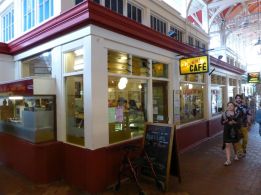Chapter Seven
After a fitful night of sleep –which she blames rather inexplicably on Matthew–Diana steps out into the morning fog of Oxford to row.
She runs into Matthew–literally–while walking back from the river with her eyes closed. She treats this as a continuation of the meditative act of rowing, though it would appear that the experts recommend that you conduct walking meditation with your eyes open. You are, after all, far less likely to run into a handsome vampire than a solid, unforgiving tree trunk.
Matthew invites Diana to share breakfast with him and she accepts. According to the Tenth Knot, the cafe Matthew frequents is based on Brown’s Café in the Oxford Covered Market. Should you be so inclined, the Tenth Knot has an entire AST Guide to Oxford for all of your fandom-related travel needs. Once inside, Diana orders a heaping plate of food–a decision that I heartily applaud. Her breakfast sounds just short of a full English, which includ es a heart-stopping combination of eggs, bacon, baked beans, toast, mushrooms, roasted tomatoes, pudding (black and white), and potatoes. They’re fabulous… if you can get through one. If you like the occasional culinary excess, I strongly recommend the blog the Fry Up Police, whose sole stated mission in life is to shame gnarly breakfasts and celebrate the very, very sexy ones.
es a heart-stopping combination of eggs, bacon, baked beans, toast, mushrooms, roasted tomatoes, pudding (black and white), and potatoes. They’re fabulous… if you can get through one. If you like the occasional culinary excess, I strongly recommend the blog the Fry Up Police, whose sole stated mission in life is to shame gnarly breakfasts and celebrate the very, very sexy ones.
In this chapter, Matthew watches Diana make a very potent, very personal mug of tea. On Deb’s blog, she indicates that Diana’s tea-drinking rituals are part of her coping strategy for anxiety and stress. She gives links to Diana’s favorite teas, including the ubiquitous PG tips, Thé Des Impressionistes by Mariage Frères, and Organic India USA Tulsi Sweet Rose Tea. I happen to prefer the Marco Polo blend by Mariage Frères, but Diana and I can certainly differ in our choice of tea.
Tea-drinking in England likely originated with King Charles II in the 1660s. Popularized by royalty, taxed out the wazoo by the government, and generally adored by the middle classes, tea eventually became a staple of the British diet. There is a UK Tea Council, whose website offers the following fantastic description of the history of tea in the UK:
Read about the exotic beginnings of tea in China and the Far East and in time how it was transported to the UK and America on the Tea Clippers.
Discover how tea was brought to England by a seventeenth century queen, and how important the tea trade was to the British East India Company, one of the most powerful commercial organisations the world has ever seen.
Learn how the phenomenal popularity of tea in the eighteenth century led to widespread smuggling and adulteration, and about the murderous lengths smugglers went to to protect their illegal trade.
Read also about the Boston Tea Party of 1773, which sparked off the American Revolution, and how rivalry between the English and the American tea traders in the nineteenth century led to the excitement of the Clipper races. And trace the social history of tea in Britain, from the early debates about its health-giving properties, to the rise of the tea bag, via the great tradition of the London Tea Auction and the role of tea in boosting morale in the World Wars.
Sign me up, y’all. Their website offers a very helpful counter for the number of cups of tea consumed in ther UK at this very moment.
Diana and Matthew’s discussion of science and philosophy taps into a broad and ongoing debate on which disciplines bring us closest to understanding the big questions of the universe. In the linked Guardian article, a scientist and a philosopher have just such a discussion about the ability of science or philosophy to answer such questions.
The All Souls Podcast discusses this chapter in Episode 8: The Fog Dissipates. The Daemons cover this chapter in Take 15!. Our episode on Chapters 7-9 is Episode 3 – Lipstick on a Bat.
If you’d like to get in touch, find us on Twitter at @chamomilenclove or e-mail us at chamomileandclovecast@gmail.com. See you in yoga class!
Best,
Cait

